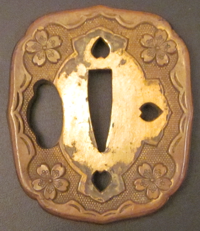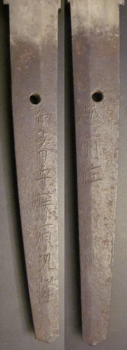Col. Bill's Samurai Sword
A Fantastic Trip Through Time
In 1963, then Colonel William (Bill) Hussey was stationed in Korea. During his time there, he
acquired a
WWII vintage "samurai" sword. Outwardly it was pretty plain and in fact somewhat shabby looking. All
Japanese officers were required to have a sword.  Each service's (Army, Navy, etc.) regulations required the sword to be of a certain
pattern but
allowed some variation. The Colonel's sword is clearly a WWII Imperial Army pattern or mount.
Each service's (Army, Navy, etc.) regulations required the sword to be of a certain
pattern but
allowed some variation. The Colonel's sword is clearly a WWII Imperial Army pattern or mount.
The sword's scabbard (Saya) is a leather cover over wood version intended for field use and is quiet
worn.
The guard (Tsuba) is in the army pattern but appears to be of higher quality than many. The collar
(Habaki)
just forward of the guard that helps hold the sword in the scabbard is plain with no decorations.
The handle
(Tsuka) is covered in sting ray skin (Same) and then artfully wrapped in a flat silk braided cord
(Tsuka-Ito) that is in excellent condition. Under the Tsuka-Ito wrap there are two small metal
decorations,
one on each side, known as Menuki.  Each
Menuki is made up of three cherry blossoms which is the symbol of the Imperial Army. The pommel cap
(Kabuto-Gane) at the butt-end of the handle and the collar (Fuchi) at the forward end of the handle
are
decorated with cherry blossoms. They are nicely detailed but otherwise undistinguished.
Each
Menuki is made up of three cherry blossoms which is the symbol of the Imperial Army. The pommel cap
(Kabuto-Gane) at the butt-end of the handle and the collar (Fuchi) at the forward end of the handle
are
decorated with cherry blossoms. They are nicely detailed but otherwise undistinguished.
It is the blade that draws the eye. Maybe that is true with all Japanese swords (Katana) but this one is somehow different. It is gracefully curved, polished and very elegant.
The Japanese have been crafting sword blades for over 1300 years. Their skill is legendary and the
cutting
quality of the blades is unmatched, even by today's technology. The process of making the blade was
very
labor intensive and time consuming. The process took weeks; especially for the highest quality
blades made
by a master swordsmiths. During the Japanese military buildup to WWII, the demand for blades
exceeded the
capacity that traditional swordsmiths could produce.  Blades
began to be mass produced using industrial equipment. The quality of these blades was significantly
less and
the problem only grew worse as the war progressed due to material shortages. The Colonel's blade has
the
appearance and all the characteristics of a handmade blade made in the traditional way. It is in
good
condition without any cracks or other defects.
Blades
began to be mass produced using industrial equipment. The quality of these blades was significantly
less and
the problem only grew worse as the war progressed due to material shortages. The Colonel's blade has
the
appearance and all the characteristics of a handmade blade made in the traditional way. It is in
good
condition without any cracks or other defects.
In the traditional fashion, the handle (Tsuka) is attached to the blade by a single bamboo peg (Mekugi) which is smaller in diameter than a pencil. Of itself, this is a mind boggling arrangement. With the handle removed, the tang (Nakago) can be seen to have characters engraved into the metal. These characters are the swordsmith's signature (Mei). They often contain more information than just the swordsmith's name and that is the case with this blade.

The left side of the tang has engraved three
characters
(Echizen Ju) which translate to "resident of Echizen". Echizen is a province in western Honsuthe
that is the
largest island of Japan.  The right side
of the
tang
contains seven engraved characters. The first three (Hoki No Kami) are an important honorary title
that was
bestowed on the swordsmith. The next four characters are the name of the swordsmith - Fujiwara
Hirotaka.
Hirotaka was a renowned swordsmith whose skills were ranked in the upper third of the swordsmiths of
his
era.
The right side
of the
tang
contains seven engraved characters. The first three (Hoki No Kami) are an important honorary title
that was
bestowed on the swordsmith. The next four characters are the name of the swordsmith - Fujiwara
Hirotaka.
Hirotaka was a renowned swordsmith whose skills were ranked in the upper third of the swordsmiths of
his
era.
Now for the drum roll. Fujiwara Hirotaka made swords, signed in this fashion, between 1655 and 1658! The Colonel's blade was more than 300 years old when he acquired it. In a real sense its true significance was hidden by the WWII mounting and its shabby condition. The Colonel had acquired a genuine "Samurai" sword made in an era when the Samurai ruled Japan.
To the Colonel, the sword was a very interesting WWII relic that he felt was special. He spoke enthusiastically of its beauty but never knew its real value. He was a decorated WWII veteran but he had fought in North Africa and Europe, not the Pacific Theater. On many occasion he would show the sword to visitors but never displayed it in his office or home. The sword spent more than three decades stored in the bottom of a foot locker. Its rediscovery began in 2013.
The blades moments in history will probably never be known. The chain of events, both ordinary and special, that 350+ years later places it in Savannah, GA must be - demands to be, fantastic. The serendipity of this find makes the story even more fascinating.
